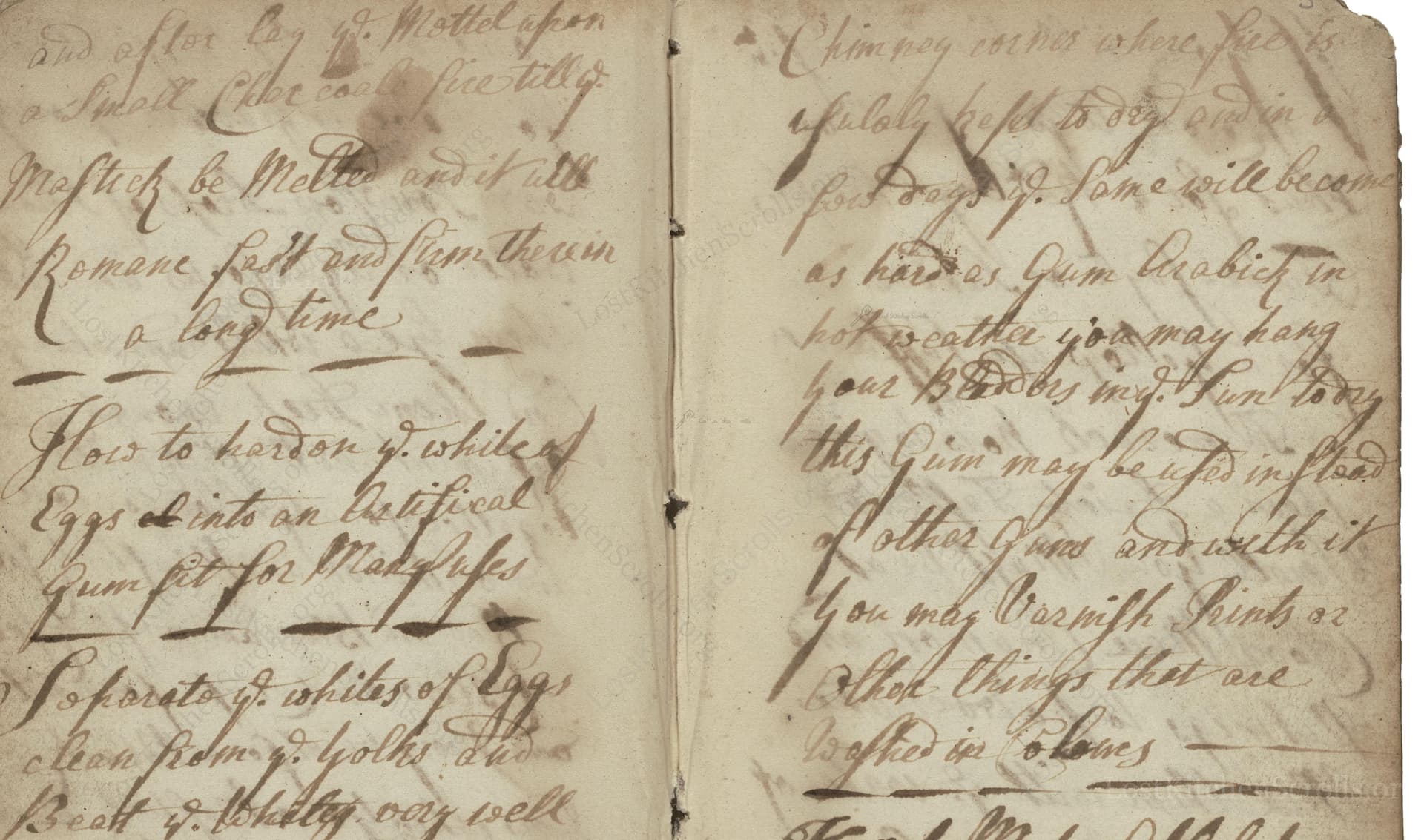How To Harden Ye Whites Of Eggs Into An Artifical Gum Fit For Many Uses
From the treasured pages of Miscellaneous collection of receipts
Unknown Author

How To Harden Ye Whites Of Eggs Into An Artifical Gum Fit For Many Uses
"Separate ye whites of Eggs clean from ye yolks And Beat ye whites very well into a cleare oyle or water and when it is So Skim off ye froth then put ye Same into Bladders and hang them in a chimney corner where fire is usualy kept to dry and in a few days ye same will become as hard as Gum Arabick in hot weather you may hang your Bladders in ye Sun to dry this Gum may be used instead of other Gums and with it you may Varnish Prints or other things that are Washed in Coloures"
Note on the Original Text
Seventeenth-century recipes were brief and practical, assuming a reader with some household knowledge. Spellings such as 'ye' for 'the' and 'cleare oyle' for 'clear oil' appear, reflecting Early Modern English orthography and habits. Quantities were rarely exact, with most details inferred from context. The description is plain but expects the cook to make judgments about when the mixture is 'very well' beaten, or when it is 'as hard as Gum Arabick'. Reading between the lines, one sees a recipe serving multiple crafts, elegantly repurposing a humble ingredient in place of pricier imports.

Title
Miscellaneous collection of receipts (1688)
You can also click the book image above to peruse the original tome
Writer
Unknown
Era
1688
Publisher
Unknown
Background
Step back into the sumptuous kitchens of the late 17th century with this historical culinary treasure, filled with tantalizing recipes and refined techniques perfect for impressing the nobility—or your most discerning dinner guests.
Kindly made available by
Folger Shakespeare Library
This recipe hails from an English manuscript of the late seventeenth century, most likely around 1688, as catalogued in 'Bd.w. A1767'. During this period, natural gums such as gum arabic were essential for bookbinding, painting, and even as craft adhesives, but may not have always been easy to procure. This creative solution, using common kitchen eggs, provided a homegrown alternative for artists and printers. The recipe also hints at the wider domestic know-how of the early modern home, where women and men both adapted household materials for artistic and practical tasks.

In the seventeenth century, cooks would have used a simple earthenware bowl and a wooden whisk to beat the egg whites, and a spoon to skim off the froth. For containing the liquid whites, small prepared animal bladders were commonly used—bladders were cleaned, tied, and repurposed as bags or casings for food and household tasks. The drying was done by suspending the filled bladders near a fireplace or sunlit window—both reliable sources of gentle warmth in the home.
Prep Time
10 mins
Cook Time
P0D
Servings
1
We've done our best to adapt this historical recipe for modern kitchens, but some details may still need refinement. We warmly welcome feedback from fellow cooks and culinary historians — your insights support the entire community!
Ingredients
- 3–4 egg whites (about 1/2 cup, from medium eggs)
- No modern substitute is needed for egg whites
- Optional: food-grade silicone pouches or sturdy freezer bags (as substitutes for animal bladders)
Instructions
- Begin by separating the whites from the yolks of fresh chicken eggs.
- You’ll need about 3–4 egg whites (roughly 1/2 cup).
- Beat the egg whites thoroughly until they turn clear and slightly foamy, emulating the appearance of oil or water; avoid whipping into peaks.
- Allow the mixture to rest, then skim off any foam or froth from the surface.
- Carefully spoon or pour the liquid egg whites into small food-safe bags, such as silicone pouches (as a modern substitute for animal bladders).
- Suspend the pouches in a warm, dry place, such as near a radiator or in a sunlit window, ensuring good air circulation.
- After several days—usually 2–5 depending on heat and humidity—the contents will harden into a translucent, gummy mass.
- This can be broken up and used as a glue, a varnish for prints, or as a binder for colors, just as you would use gum arabic.
Estimated Calories
18 per serving
Cooking Estimates
Preparing and beating the egg whites takes only a few minutes. Most of the time is spent waiting for the egg whites to dry and harden in a warm place, which can take a few days. This recipe yields a small batch of hardened egg white glue, about 1–2 tablespoons, and each serving contains minimal calories since only the egg white solids remain.
As noted above, we have made our best effort to translate and adapt this historical recipe for modern kitchens, taking into account ingredients nowadays, cooking techniques, measurements, and so on. However, historical recipes often contain assumptions that require interpretation.
We'd love for anyone to help improve these adaptations. Community contributions are highly welcome. If you have suggestions, corrections, or cooking tips based on your experience with this recipe, please share them below.
Join the Discussion
Rate This Recipe
Dietary Preference
Main Ingredients
Culinary Technique
Occasions

Den Bockfisch In Einer Fleisch Suppen Zu Kochen
This recipe hails from a German manuscript cookbook compiled in 1696, a time whe...

Die Grieß Nudlen Zumachen
This recipe comes from a rather mysterious manuscript cookbook, penned anonymous...

Ein Boudain
This recipe comes from an anonymous German-language manuscript cookbook from 169...

Ein Gesaltzen Citroni
This recipe, dating from 1696, comes from an extensive anonymous German cookbook...
Browse our complete collection of time-honored recipes



